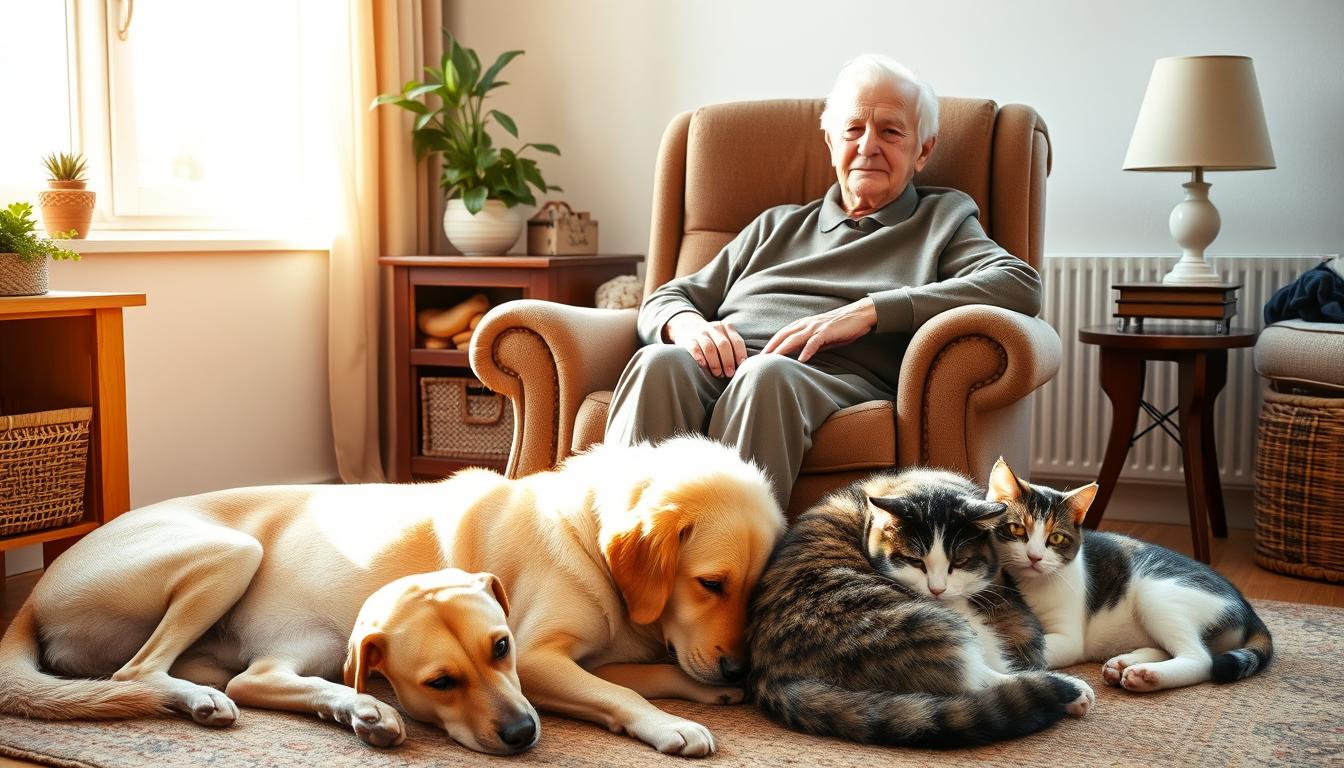Retirement brings many new chances, and getting a pet is one of the best. Having a pet in your golden years adds joy and purpose. Pets help 95% of owners feel less lonely, showing their big impact.
Pets bring many benefits to seniors. They can lower depression by 36% compared to those without pets. Owning a dog can even improve heart health by 50% for those who walk regularly.
For 70% of seniors in home care, pets bring love and a sense of duty. This is very helpful when you retire. It adds structure and happiness to your days.
Key Takeaways
- Pet ownership can reduce stress levels by up to 60% among seniors
- 95% of pet owners report decreased feelings of loneliness
- Seniors with pets are 36% less likely to experience depression
- Dog walking can lead to a 50% improvement in cardiovascular health
- 70% of seniors in home care benefit from pet companionship
- Pet-related events boost community engagement for 80% of owners
Understanding the Impact of Pet Companionship in Later Life
Pets do more than just keep seniors company. Studies show they greatly improve health and life quality. A survey of 2,068 U.S. pet owners, including 122 aged 65 and older, uncovered the benefits of pet ownership.
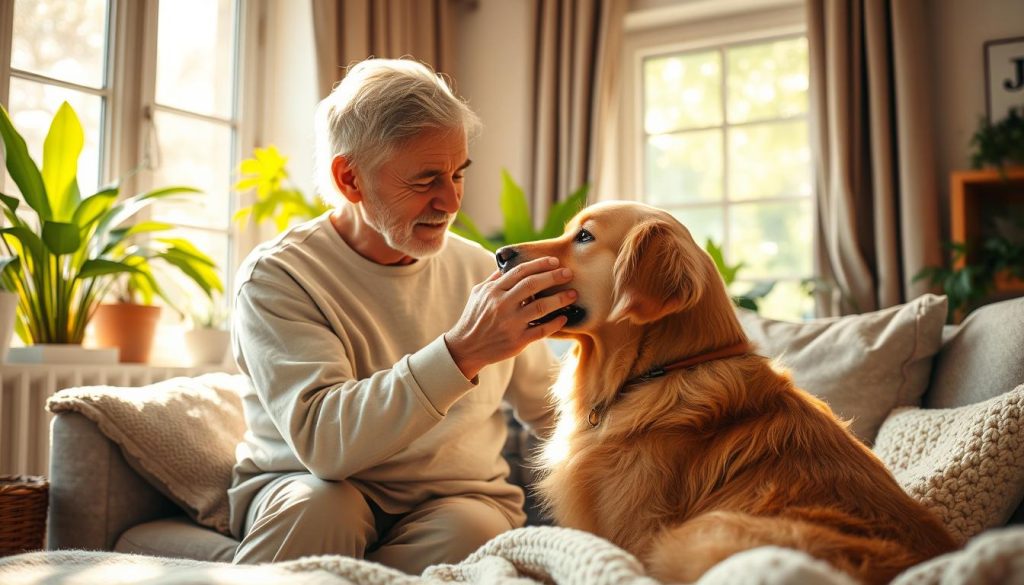
Physical Health Benefits
Pets can make seniors healthier. Activities like dog walking keep them moving. They also have lower blood pressure and cholesterol, cutting down heart disease risks.
Mental Wellbeing Advantages
Pets help fight loneliness in the elderly. A University of York study found pets reduce isolation. They also boost mood and offer emotional support, helping those who have lost a partner or are lonely.
Social Connection Opportunities
Pets can bring seniors together. A University of Southampton study showed pets increase social interaction. Dog walks and pet talks can lead to new friendships.
Yet, owning a pet comes with challenges like money and mobility issues. Despite this, the benefits of pet companionship for seniors are clear. It’s a great choice for many retirees.
Why Get a Pet During Retirement
Getting a pet in retirement can change your life for the better. It brings many benefits that make your retirement more enjoyable. One big reason is the companionship pets offer. A study found that 71% of retirees get pets for this reason.
Pets are good for your mind and body. They can make you 36% less likely to feel depressed. Also, 70% of pet owners say they feel less stressed with their pets around.
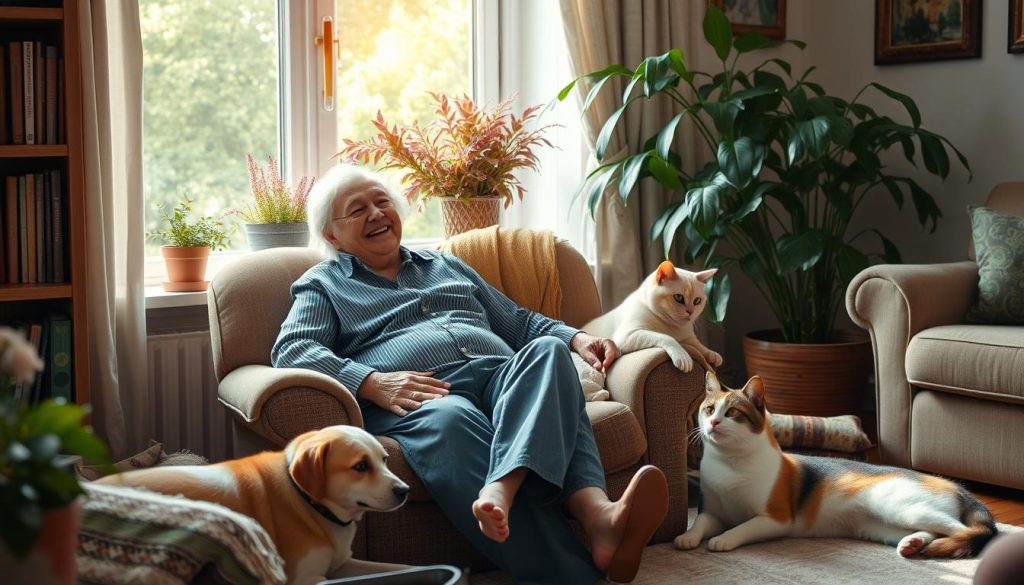
A pet can give your day a structure, making you feel more purposeful. In fact, 50% of retirees say caring for a pet gives them a sense of meaning. This can help you adjust to not working as much.
Pets can also help you meet new people. About 80% of dog owners say their pets help them meet others. This is great if you’re moving to a new retirement community.
| Benefit | Percentage |
|---|---|
| Reduced stress levels | 70% |
| Increased social interactions | 80% |
| Reduced risk of depression | 36% |
| Greater sense of purpose | 50% |
In short, getting a pet in retirement can add joy and companionship to your life. It can also improve your health, mental wellbeing, and social life. It’s a great choice for making your retirement years happy and fulfilling.
Health Benefits of Senior Pet Ownership
Having a pet in later life can greatly improve health. Pets offer more than just emotional support. They can also lead to real physical health benefits.
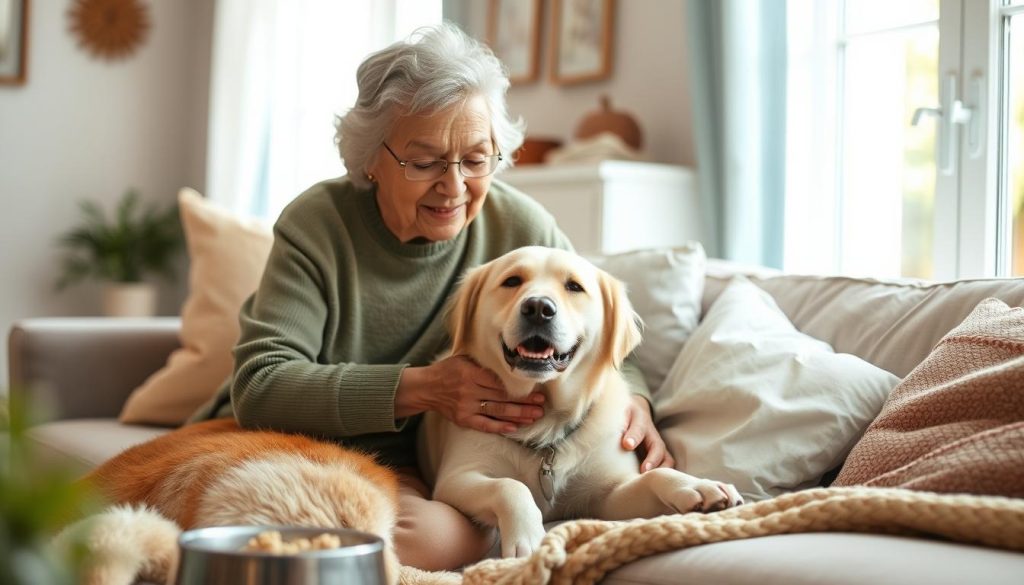
Reduced Blood Pressure and Stress Levels
Studies show pets can lower blood pressure and stress. They can make heart rates and blood pressure go down. This is great for seniors with high blood pressure or stress.
Increased Physical Activity
Having a pet, like a dog, means more exercise. Dog owners walk 22 minutes more each day. This adds up to 2,760 more steps daily. It helps with fitness and weight control, with dog owners often being healthier.
Enhanced Cardiovascular Health
Pets help lower stress and increase activity. This improves heart health. Pet owners have better cholesterol and triglyceride levels. This makes pets a key part of heart health for seniors.
| Health Metric | Impact of Pet Ownership |
|---|---|
| Blood Pressure | Lower levels observed |
| Daily Walking Time | Increased by 22 minutes |
| Cardiovascular Disease Risk | Decreased risk noted |
Pet ownership greatly benefits senior health. It offers a natural way to improve life in retirement.
Creating Daily Structure and Purpose
Retirement can feel like a big empty space without a routine. But, having a pet can fill that gap. A University of Michigan poll showed pets give 73% of older adults a sense of purpose. Also, 62% of them stick to a routine thanks to their pets.
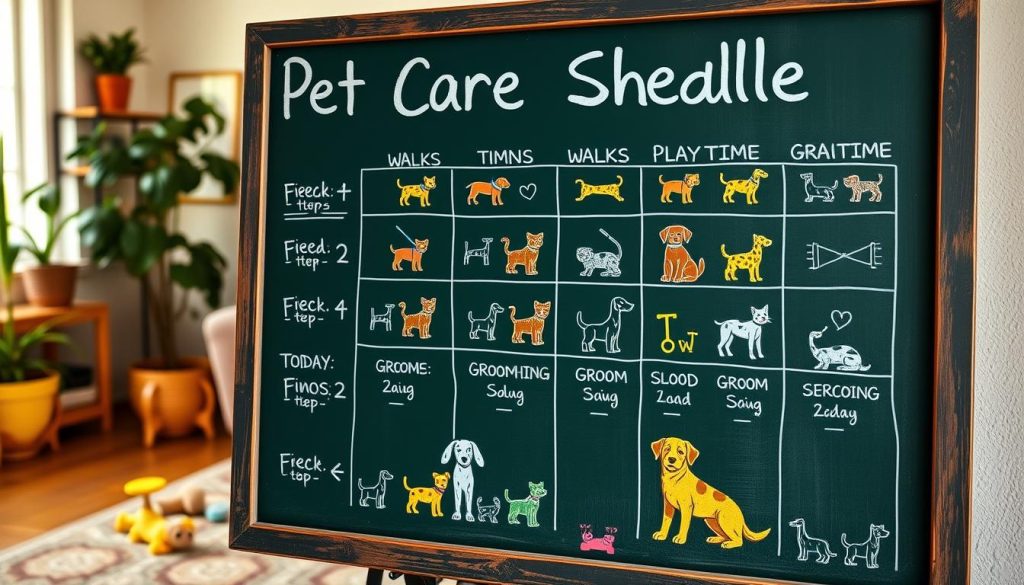
Setting up a pet care schedule is a smart move. It brings order to your days. Feeding, walks, and grooming create daily routines. For example, morning and evening dog walks give you something to look forward to.
These routines help you sleep better and feel more alive. They’re key for a happy retirement.
Caring for a pet also lifts your mood. It makes you feel needed and motivated. Pet ownership in retirement cuts down loneliness and boosts social life. Dog walks often lead to chats with others.
Having a pet also improves your health. Dog owners move more, which is good for the heart and mind. It makes you happier and sharper.
“My dog, Bella, has given my retirement a whole new lease of life. Our daily walks and playtime keep me active and connected with my community. She’s not just a pet; she’s my reason to get up and embrace each day.” – Margaret, 68, retired teacher
Adding pet care to your retirement is a smart choice. Your pet gets love, and you get structure, purpose, and a friend for life.
Choosing the Right Pet for Your Lifestyle
Finding the right pet is key to a happy retirement. Think about your daily life, home, and how much care you can give.
Activity Level Considerations
Your energy and how you move are important. A study shows 50% of seniors might struggle with moving around. This could change how you care for a pet.
If you love going for fast walks, a lively dog might be perfect. But, if you prefer a calm home, a gentle cat or small dog could be better.
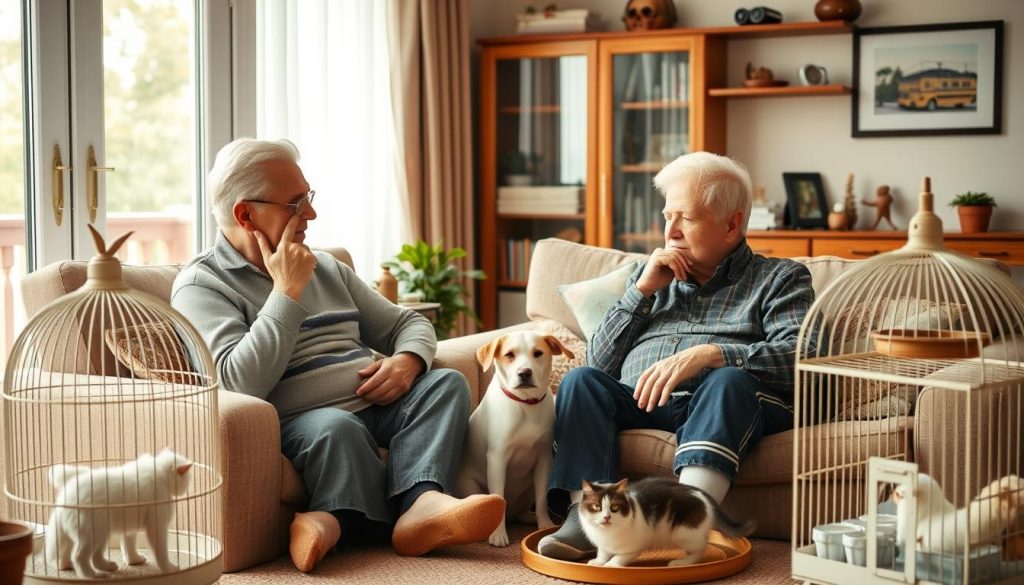
Living Space Requirements
The size of your home affects what pet you can have. Big dogs need lots of room, while cats and small dogs are happy in smaller spaces.
Living in a ground-floor flat or bungalow in a pet-friendly area is great. It makes it easy to take your pet outside.
Maintenance and Care Needs
Think about the long-term care of a pet. Dogs need walks and grooming, while cats are more independent. Smaller pets like fish or birds are easier to care for.
Remember, 60% of seniors might find it hard to go to vet appointments without help. So, think about what you might need in the future.
By considering these points, you can find a pet that fits well into your retirement. It will bring happiness and company to your later years.
The Joy of Senior Pet Adoption
Adopting a senior pet brings joy and fulfillment to retirees. These older animals often have set personalities, making it easier to find a good match. They usually need less energy, perfect for older adults who want a pet but don’t need a high-energy one.
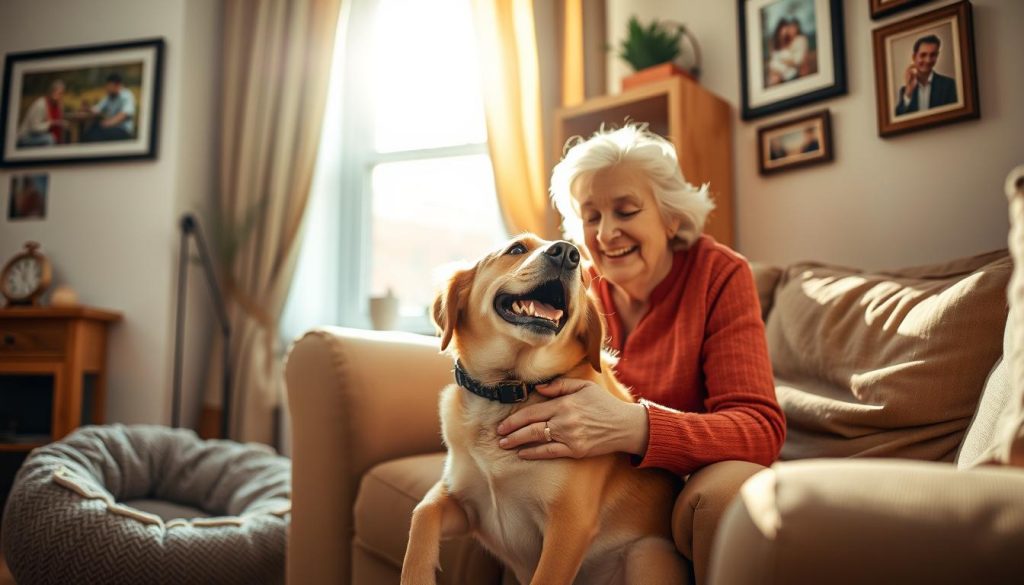
Providing a loving home to an older animal is deeply rewarding. Studies show that 60% of elderly people feel less lonely after adopting a pet. This act of kindness not only improves the lives of retirees but also saves lives. Older pets are often the first to face euthanasia in shelters.
Older animal rescue offers unique benefits:
- Established personalities make matching easier
- Lower energy requirements suit retirees’ lifestyles
- Emotional fulfilment from giving a second chance
- Reduced feelings of loneliness and isolation
A survey found that 60% of people who adopt pets in their golden years feel more joyful and purposeful. This mutual benefit creates a strong bond between the animal and the retiree, improving their quality of life.
“Adopting my senior cat, Whiskers, was the best decision I’ve made. She’s given me a new lease on life,” shares Margaret, a 72-year-old retiree from Bristol.
Consider senior pet adoption or older animal rescue for your retirement years. It’s a life-changing experience that brings companionship, purpose, and joy.
Financial Planning for Pet Ownership
Planning for retirement pet expenses is key for a happy life with your furry friend. A good pet care budget prepares you for both regular and unexpected costs.
Routine Care Costs
Dog owners spend about £3,560 a year on their pets. This includes food, vet visits, and supplies. It’s smart to include these costs in your retirement budget to avoid money troubles.
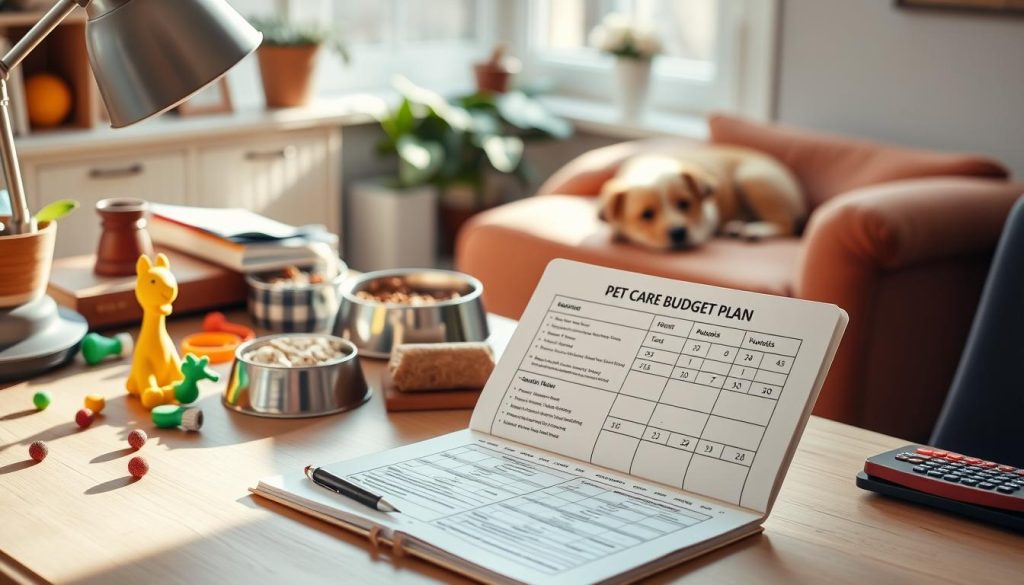
Emergency Fund Planning
Unexpected vet bills can be very expensive. A friend’s niece had to pay £8,000 for her cat’s cancer treatment. To be ready for such costs, save a pet emergency fund. Aim for three to six months of living expenses, including pet care.
Insurance Considerations
Pet insurance can be a big help. In 2024, a policy with £5,000 annual coverage costs about £50 a month. It’s best to insure your pet when they’re young and healthy, as pre-existing conditions aren’t covered.
Owning a pet in retirement brings joy and companionship. But it needs financial planning. By budgeting for routine care, emergencies, and insurance, you can enjoy your golden years with your pet without money worries.
Establishing Pet Care Routines
Creating a pet care schedule is key for retirees with pets. A good retirement daily routine that includes pet care is very beneficial. It helps both you and your pet. Studies show 73% of seniors say pets improve their life quality.

Begin with regular feeding times. Pets like routine, so feed them at the same hours every day. This meets their nutritional needs and helps organize your day. Dogs need daily walks or play to stay healthy and happy.
Grooming is also important. Depending on your pet’s breed, you might brush their coat, trim nails, or clean ears. These activities are great for bonding and keep your pet healthy.
- Morning: Feeding and brief walk or playtime
- Midday: Short interaction or training session
- Evening: Second feeding and longer exercise session
- Weekly: Grooming and health check
Don’t forget about vet visits. Schedule them and add them to your routine. A good pet care schedule meets your pet’s needs and makes your retirement better.
Building Bonds Through Pet Activities
Retirement is a great time to get closer to our pets. Doing fun activities with them can make our days better and keep us both happy.
Daily Exercise Options
Exercise is important for pets and their owners. Going for walks helps you stay fit and lets you see new places. Dogs need about 30 minutes to an hour of play each day, based on their breed and energy.
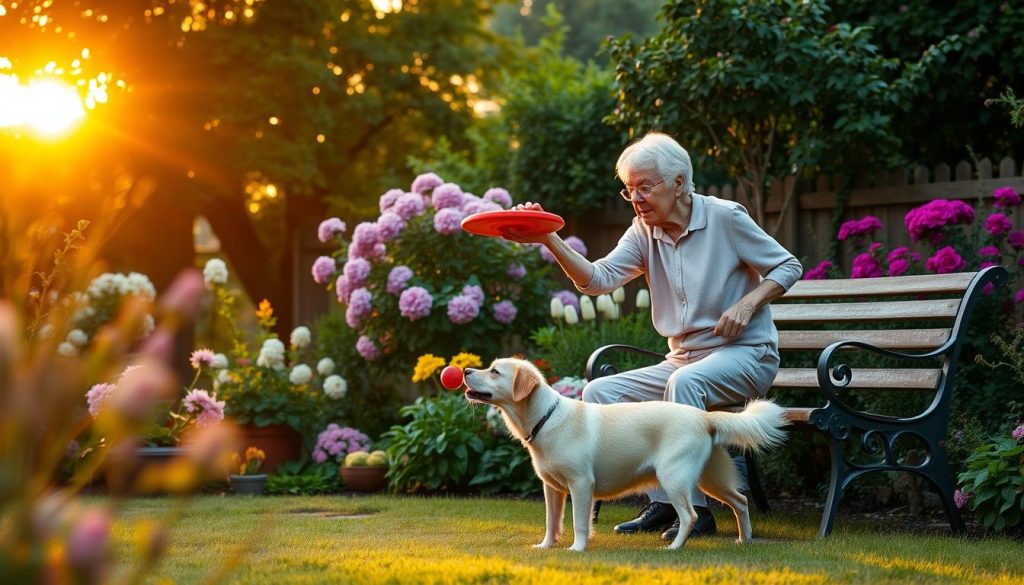
Playtime and Training
Playing together makes your bond stronger and keeps your pet’s mind active. Learning new tricks or commands is fun for both of you. Toys and puzzle feeders can make playtime even more enjoyable.
Grooming Sessions
Grooming is a special time to bond. Brushing, bathing, and trimming nails keeps your pet healthy and brings you closer. These moments are calming for both of you.
Joining pet-friendly groups is a great idea. Dog cafés, for example, are a lovely place to meet other pet lovers. They add fun to your retirement and help you meet new people.
“Engaging in pet bonding activities has truly enriched my retirement. It’s given me a sense of purpose and joy I never expected,” shares Mary, a retired teacher and proud dog owner.
Being consistent and patient is key to bonding with your pet. Adding these activities to your daily life will make your retirement rewarding for both of you.
Safety Considerations for Senior Pet Owners
Creating a safe space for seniors and their pets is key for a happy home. Following pet safety tips and caring for pets in a way that’s friendly to seniors can lower risks. It also makes life better for both.
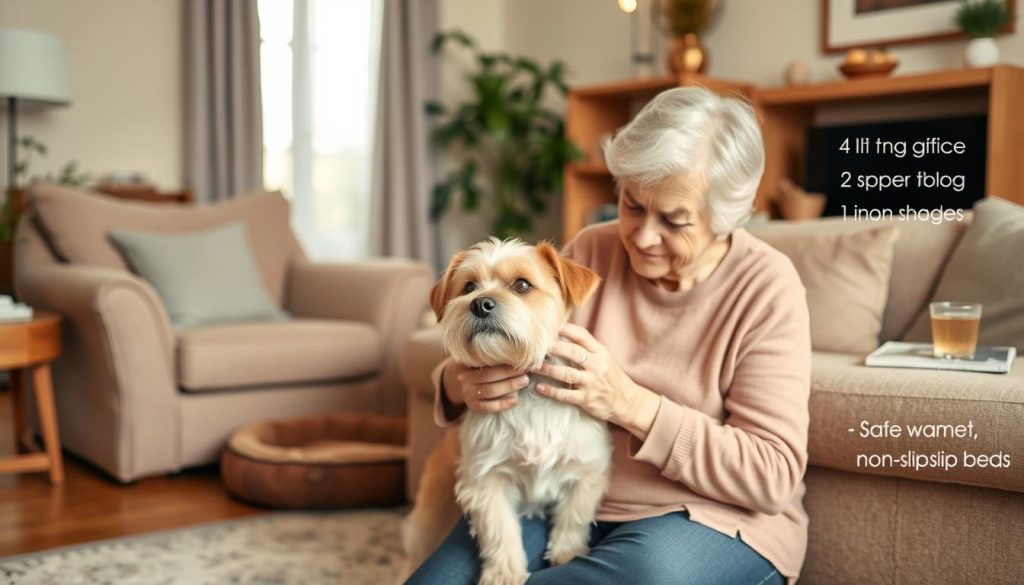
One big worry for senior pet owners is falling. To help, keep pet toys and food bowls where they’re easy to get to. Think about using raised feeding stations to avoid bending. For dog owners, get non-slip leashes and harnesses to keep control during walks.
It’s also important to take pets for regular vet visits. If moving around is hard, look into mobile vet services or pet taxi. These can make it easier for senior pet owners to get care.
- Install secure gates to prevent pets from accessing stairs
- Use non-slip mats in areas where pets frequent
- Keep pet supplies organised and within reach
- Consider pet insurance to manage unexpected veterinary costs
The Cinnamon Trust is a big help for those with limited mobility. They offer dog walking and vet transport. This helps pets get the care they need without putting their owners at risk.
| Safety Measure | Benefit |
|---|---|
| Non-slip flooring | Reduces fall risk for both pets and owners |
| Pet identification tags | Ensures quick reunion if pet gets lost |
| Pet-proofed living spaces | Prevents accidents and ingestion of harmful items |
By following these safety tips and caring for pets in a way that’s good for seniors, older adults can enjoy their pets. They can do this while keeping their homes safe and comfortable.
The Social Benefits of Pet Ownership
Pet ownership is a big plus for retirees. These pets do more than just cuddle; they help make new friends and get involved in the community. They bring joy and connection, improving life quality.
Community Connections
Pets, like dogs, are great at starting conversations. A simple walk can turn into a chat with others. Studies show owning a pet can increase social interactions by 25% in retirement communities.
This is key, as retirement can make people feel more.
Pet-Related Social Activities
Getting involved in pet activities can really boost a retiree’s social life. Here are some ideas:
- Obedience classes
- Pet meetups in local parks
- Volunteering at animal shelters
- Joining pet owner support groups
These activities are good for pets and help retirees meet new people. In fact, 67% of retirees with pets feel more active and involved in their community.

Pets offer more than just company. They give a sense of purpose and routine, with 60% of retirees saying pets help their daily life. This mix of social time and routine fights off loneliness, making pets essential in retirement.
Managing Pet Care When Travelling
Planning retirement travel often means thinking about pet care. With 25% of retirees taking their pets on motor home trips, pets are a big part of many adventures. But, for those who can’t bring their pets, finding good care is key.
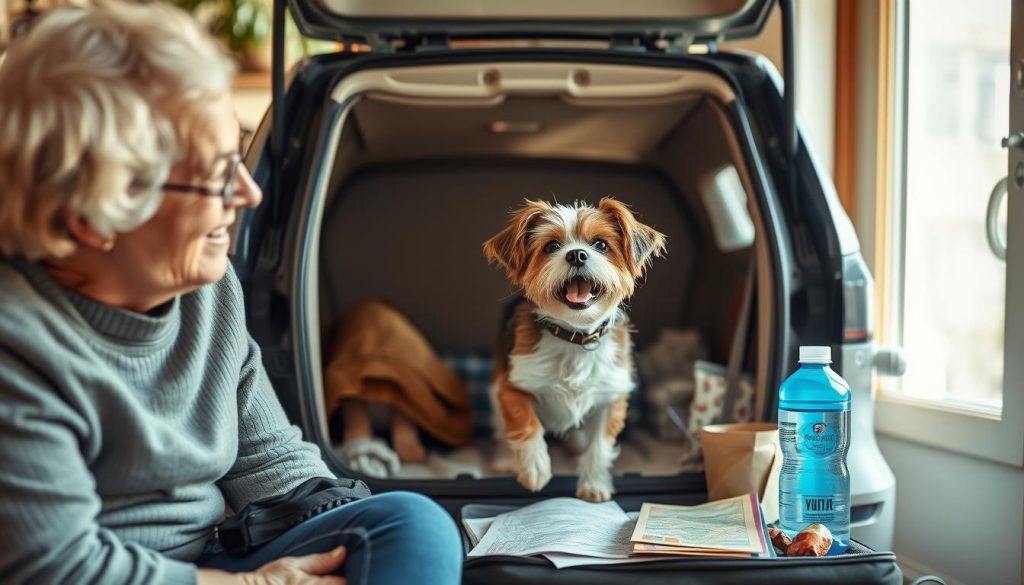
When flying, airlines usually let 4 pets in-cabin per flight. Booking early is a must, as pet travel spots are hard to find online. If your plans change, it can be tough to re-book with pets.
Here are some tips for leaving pets behind:
- Look into pet-sitting services or boarding facilities
- Try a trial day or weekend with the sitter before you go
- Ask dog-loving friends or family without pets
- Check out mobile vet services, which are growing by 20% in five years
Older dogs might get stressed when away from their owners. It’s good to know that 70% of retirement communities now allow pets. This could be a great option if you’re looking for a pet-friendly place to live.
Pet-Friendly Home Modifications
Creating pet-friendly living spaces is key for retirees who want to live with their pets. Making your home safe and comfy for both you and your pet is essential. This ensures a happy and safe environment for everyone.
Installing ramps is a great first step. They help pets with mobility issues and are useful for seniors too. Slip-resistant flooring is also vital. It prevents accidents for both pets and their owners.
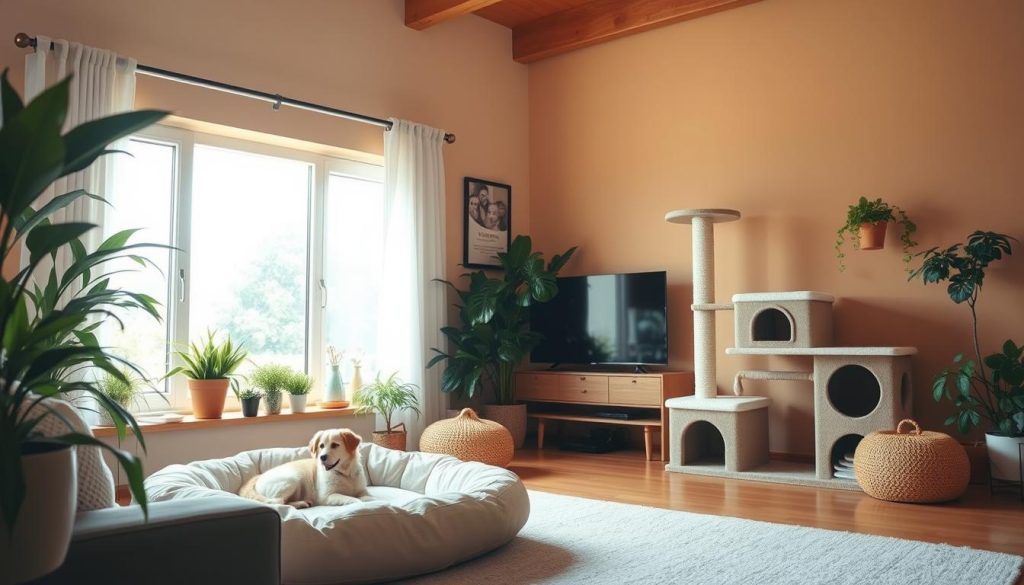
Setting up feeding and watering stations at a comfortable height is helpful. Using elevated bowls or automatic feeders makes mealtime easier. Designating a pet area, like a cosy corner, keeps your home tidy and makes your pet feel at home.
Safety is very important in pet-friendly homes. Make sure to secure loose wires and choose pet-safe plants. These simple changes can greatly improve life for you and your pet.
| Modification | Benefit for Seniors | Benefit for Pets |
|---|---|---|
| Ramps | Reduced fall risk | Easier mobility |
| Slip-resistant flooring | Improved stability | Prevents slipping |
| Elevated feeding stations | Less bending required | Comfortable eating position |
| Secure wiring | Reduced tripping hazards | Prevents chewing accidents |
By making these pet-friendly changes, you can create a caring space for you and your pet. This ensures many happy years together.
Support Systems and Resources
For seniors, having pets is a big joy. But, it’s important to have help to care for them. There are many resources out there to make pet care easier and more fun for retirees.
Local Pet Services
Many places have special services for seniors with pets. You can find mobile groomers, dog walkers, and pet sitters who come to your home. This is great for those who can’t get out much, as it keeps pets happy and healthy.
Emergency Care Options
It’s key to know where to go in an emergency. Look up 24-hour vet clinics and pet ambulance services near you. Some areas even have emergency pet care hotlines for quick advice.
Pet Owner Communities
Being part of pet owner groups is really helpful. These groups offer support, tips, and a chance to meet others. You can find online forums and local groups to share your pet experiences with others.
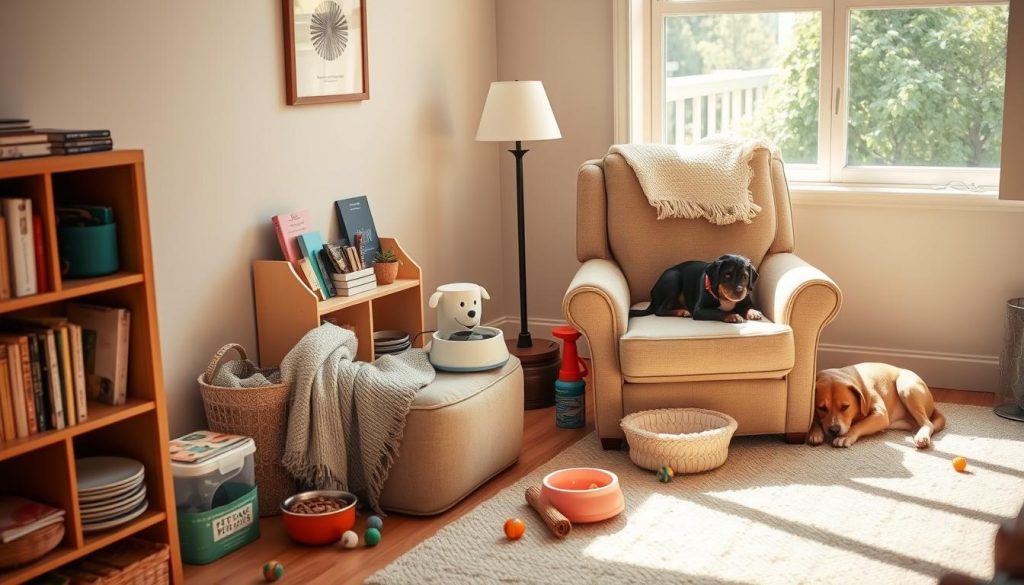
| Resource Type | Benefits | Availability |
|---|---|---|
| Mobile Pet Services | Convenient in-home care | Most urban areas |
| Emergency Vet Care | 24/7 medical support | Major cities and towns |
| Online Pet Communities | Advice and social connection | Accessible nationwide |
By using these support systems, retirees can enjoy their pets more. Remember, asking for help is okay. It means you and your pet can both have a great time in your golden years together.
Health Monitoring for Both Pet and Owner
It’s vital to watch over the health of senior pets and the well-being of retirees. Regular health checks for you and your pet can greatly improve your golden years.
Research indicates that having a pet in retirement can boost your health. Dog owners, for example, tend to move more, which cuts down heart disease risk by 40%. Also, playing with dogs can lower blood pressure by 10-15 mmHg.
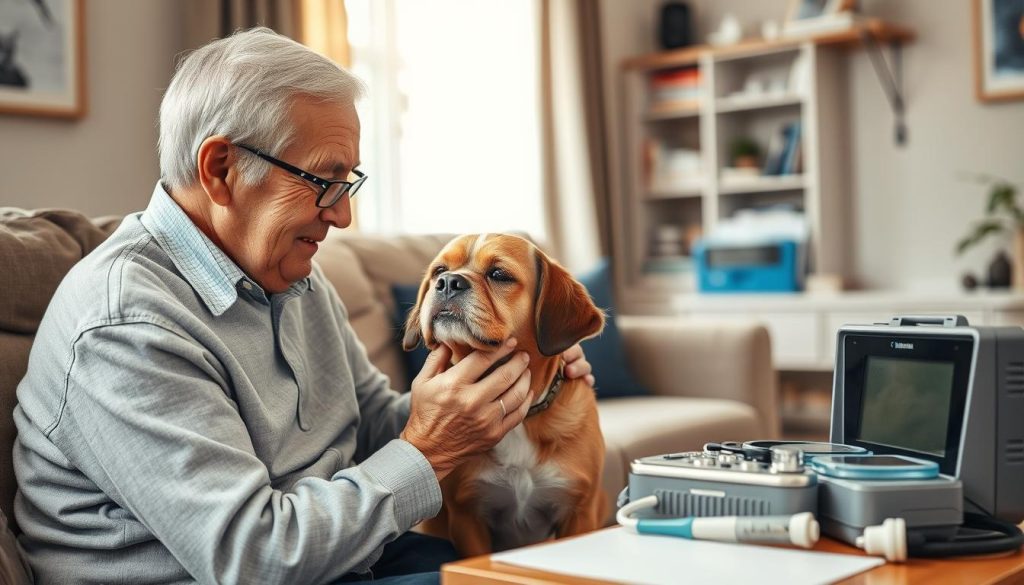
To ensure both you and your pet stay healthy, remember these important tips:
- Make sure to schedule vet visits for your pet
- Keep an eye on your pet’s diet and weight
- Stay on top of vaccinations and preventative care
- Find daily exercises that are good for both of you
- Notice any changes in your pet’s behaviour or movement
Looking after a pet can also help you stay healthy. It adds structure to your day and encourages you to stay active. In fact, 70% of pet owners in retirement villages say their pets have improved their emotional well-being.
| Health Benefit | Percentage Improvement |
|---|---|
| Reduced loneliness and depression | 22% |
| Increased physical activity | 30% |
| Decreased stress levels | 30% |
| Enhanced community connectedness | 50% |
By prioritising senior pet health and retirement wellness, you’re investing in a brighter, healthier future for both you and your pet.
Conclusion
Pets bring great benefits to seniors in retirement. Studies show that 75% of seniors feel better with a pet around. They also see a 30% drop in stress and up to 10% lower blood pressure.
Seniors with pets get more exercise too. They take about 2,760 extra steps a day. This is 22 minutes more of activity. It helps their heart health, reducing the risk of heart disease.
Even small pets like rabbits can make a big difference. They increase engagement by 40% in those with cognitive issues. Owning a pet in retirement can make life more fulfilling and healthy.
More senior living communities now welcome pets. Adopting from shelters is also cheaper than buying from breeders. As we’ve seen, pets add joy, purpose, and activity to retirement.
